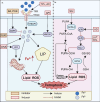Insights into emerging mechanisms of ferroptosis: new regulators for cancer therapeutics
- PMID: 40131564
- PMCID: PMC11937073
- DOI: 10.1007/s10565-025-10010-0
Insights into emerging mechanisms of ferroptosis: new regulators for cancer therapeutics
Abstract
Ferroptosis is an iron-dependent form of regulated cell death characterized by the accumulation of iron-dependent lipid peroxides, which has been implicated in the pathogenesis of various diseases, and therapeutic agents targeting ferroptosis are emerging as promising tools for cancer treatment. Current research reveals that ferroptosis-targeted therapies can effectively inhibit tumor progression or delay cancer development. Notably, natural product-derived compounds-such as artemisinin, baicalin, puerarin, quercetin, kaempferol, and apigenin-have demonstrated the ability to modulate ferroptosis, offering potential anti-cancer benefits. Mechanistically, ferroptosis exhibits negative glutathione peroxidase 4 (GPX4) regulation and demonstrates a positive correlation with plasma membrane polyunsaturated fatty acid (PUFA) abundance. Moreover, the labile iron pool (LIP) serves as the redox engine of ferroptosis. This review systematically analyzes the hallmarks, signaling pathways, and molecular mechanisms of ferroptosis, with a focus on how natural product-derived small molecules regulate this process. It further evaluates their potential as ferroptosis inducers or inhibitors in anti-tumor therapy, providing a foundation for future clinical translation.
Keywords: Cancer; Cell death; Ferroptosis; Lipid peroxidation; Nature products.
© 2025. The Author(s).
Conflict of interest statement
Declarations. Competing interests: The authors declare no competing interests.
Figures





References
-
- Adham AN, Abdelfatah S, Naqishbandi AM, Mahmoud N, Efferth T. Cytotoxicity of apigenin toward multiple myeloma cell lines and suppression of iNOS and COX-2 expression in STAT1-transfected HEK293 cells. Phytomedicine. 2021;80:153371. 10.1016/j.phymed.2020.153371. - PubMed
-
- Balint GA. Artemisinin and its derivatives: an important new class of antimalarial agents. Pharmacol Ther. 2001;90:261–5. 10.1016/s0163-7258(01)00140-1. - PubMed
Publication types
MeSH terms
Substances
Grants and funding
LinkOut - more resources
Full Text Sources
Medical

